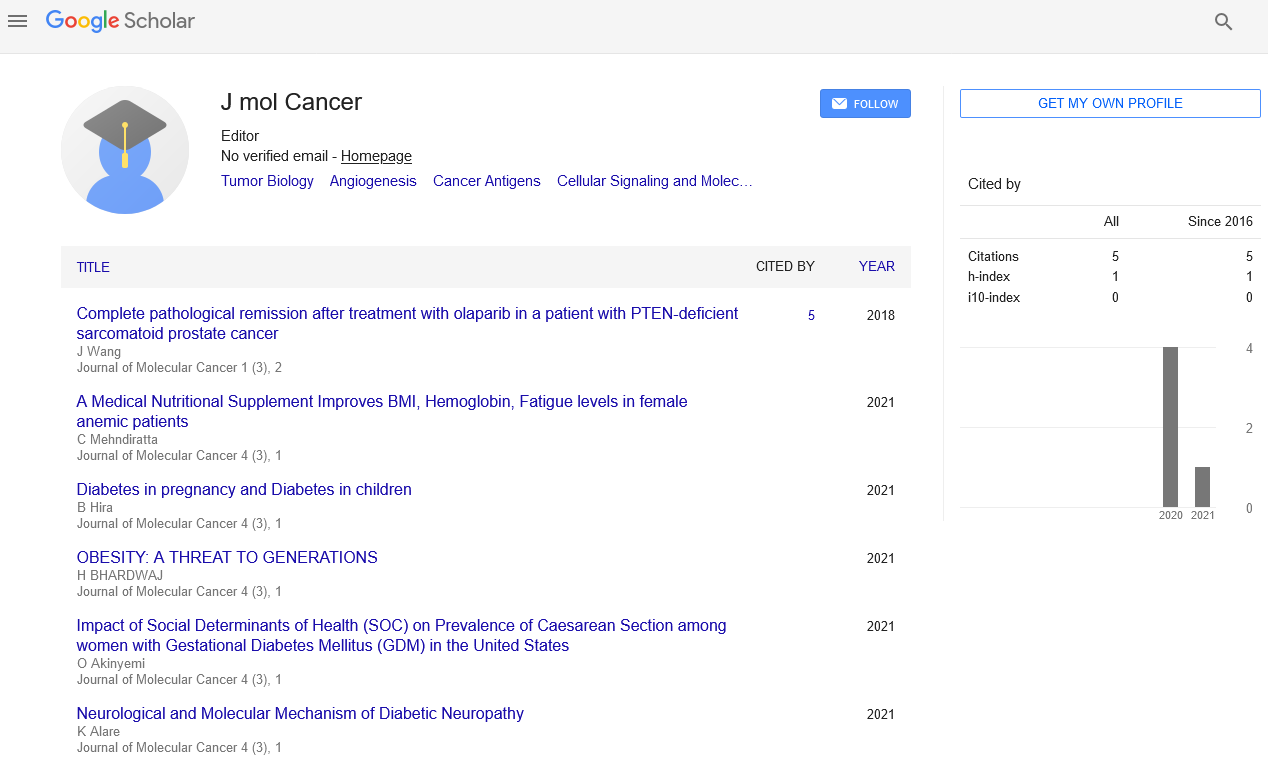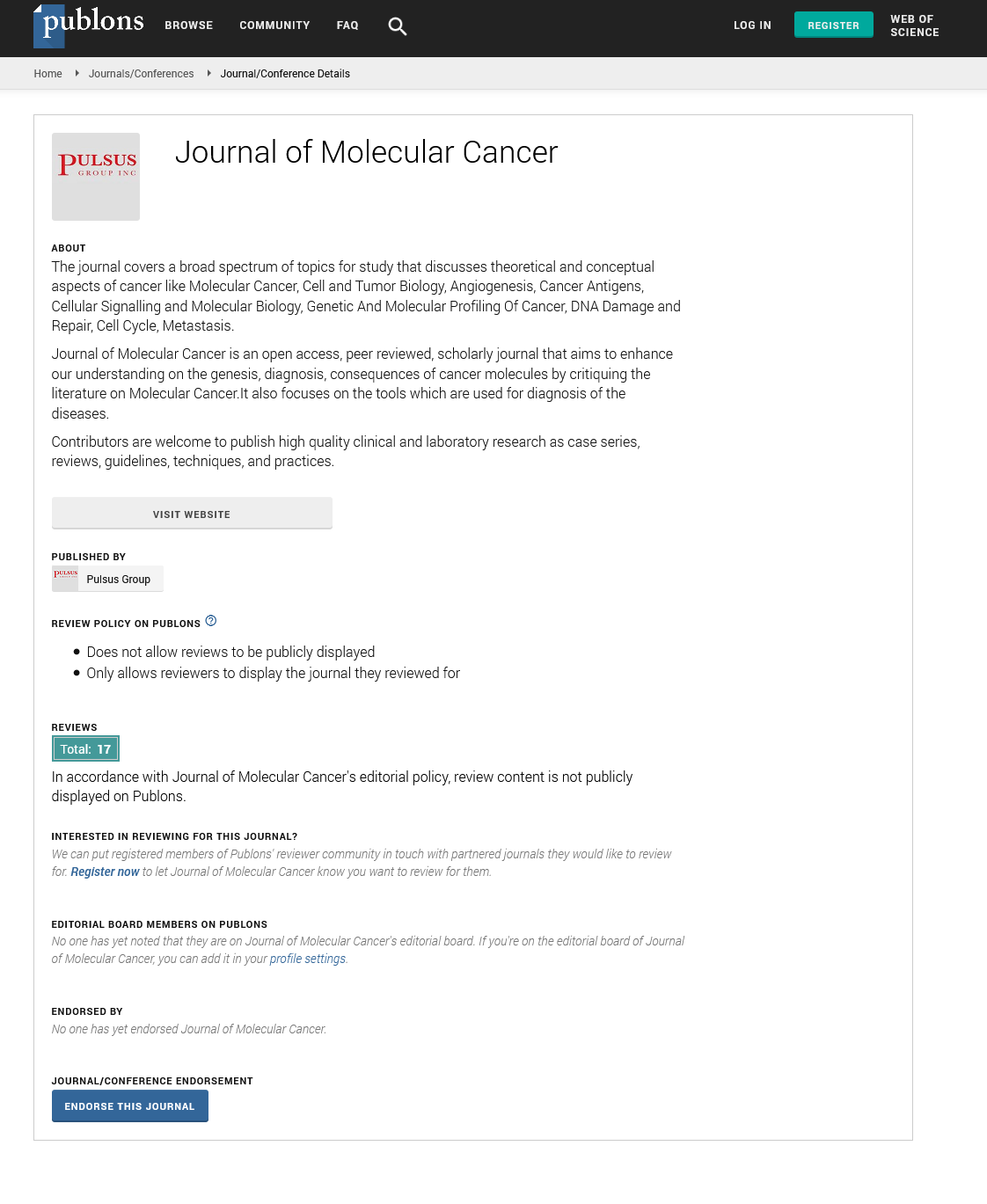Role of Cancer stem cells in drug resistance of ER+ breast Cancer
Received: 03-Jul-2018 Accepted Date: Jul 30, 2018; Published: 10-Aug-2018
Citation: Ashour F, Kamal Md. Role of Cancer stem cells in drug resistance of ER+ breast Cancer. J Mol Cancer. 2018;2(1):11-12
This open-access article is distributed under the terms of the Creative Commons Attribution Non-Commercial License (CC BY-NC) (http://creativecommons.org/licenses/by-nc/4.0/), which permits reuse, distribution and reproduction of the article, provided that the original work is properly cited and the reuse is restricted to noncommercial purposes. For commercial reuse, contact reprints@pulsus.com
Abstract
Breast cancer (BC) is classified into ER+ and ER− tumors based on Estrogen Receptor (ER) status. ER+ tumors exhibit higher levels of resistance to chemotherapy compared to ER− tumors. It was shown that BCL-2, TP53, BAX and NF-ΚB are involved in drug resistance in the ER+ tumors. Cancer Stem Cells (CSCs) were shown to be the origin of cancer and play an important role in drug resistance. Here we introduce a commentary on our previously published study entitled (“Estrogen Receptor positive breast tumors resist chemotherapy by the overexpression of P53 in Cancer Stem Cells”) where we tested the hypothesis that CSCs of the ER+ tumors resist drug through the overexpression of BCL-2, TP53, BAX and NF-ΚB. CSCs (untreated or treated with Doxorubicin (DOX)) were isolated from MCF7 (ER+) and MDA-MB-231 (ER−) cell lines. mRNA expression levels of BCL-2, TP53, BAX and NFKB were detected by quantitative real time PCR (qPCR) with and without treatment. Interestingly TP53 showed a striking increase in its expression in CSCs of the ER+ MCF7 cells compared to bulk cancer cells. In addition, TP53 showed exceptionally elevated level of mRNA expression in MCF7-CSCs compared to MDA-MB-231-CSCs. These results suggest that CSCs in the ER+ cells avoid the effect of drug treatment by increasing p53 expression.
Keywords
Breast cancer; ER+ tumors; drug resistance.
Breast cancer (BC) is one of the most sensitive tumors to chemotherapy, however, some patients could resist drugs and their tumors eventually relapse [1]. Breast tumors are classified based on their Estrogen receptor (ER) expression into; ER+ and ER– tumors [2]. It was shown that ER+ tumors have a higher ability to resist chemotherapy compared to ER– tumors [3]. ABC transporters may have a role in Estrogen/ER-induced drug resistance. Estrogen increased the cytoplasmic concentration of P-glycoprotein in ER+ MCF7 cells which were resistant to DOX [4].
Breast cancers that express high levels of ER, have high expression levels of ABCC11 transporter, supporting the notion that expression of ABCC11 in ERα+ breast cancers could explain reduced sensitivity to chemotherapy [5]. Breast cancer is a heterogeneous disease comprising a wide range of different cell subpopulations with various levels of aggressiveness. Tumor heterogeneity adds an extra layer of complexity to cancer treatment where not all tumor cells in the same tumor mass respond equally to a given drug. Identification of the cell subset prone to resist drugs is a critical step in tackling cancer recurrence.
Recently, Alhaj and his colleagues showed that injecting mice with millions of bulk tumor cells is required to initiate a new tumor suggesting that not all tumor cells able to produce a new tumor mass. The same authors were then able to isolate a cell subset which has high tumor initiating capacity (tumor initiating cancer stem cells (CSCs)). Very interestingly, they found that few CSCs are required to form new tumor in mice. Moreover, CSCs were shown to have high resistance to therapy, probably due to their slow cell cycle [6]. Others showed that stem cells are more resistant to apoptosis than differentiated cells. CSCs have high expression levels of the Bcl-2 family genes, ABC transporters such as BCRP and multidrug resistanceassociated proteins [7,8], all of which are known to play important roles in drug resistance. So it is very important to develop strategy to target CSCs which eventually improve patients’ outcome. Experimental data have shown that BCL-2, P53, BAX and NF-ΚB play a role in drug resistance and their expression differ between ER+ and ER– tumors before and after drug treatment [9 -11]. Together with the notion that CSCs are the ones which resist drugs and cause tumor recurrence, one may think that the expression of these genes is particularly manipulated in CSCs of the ER+ tumors.
In a previously published study [12], we investigated the mRNA expression levels of BCL-2, P53, BAX and NF-ΚB in bulk tumor cells and CSCs in ER+ (MCF7) and ER- (MDA-MB-231) cell lines with and without DOX treatment.
Methods
CSCs, unlike other cells, are able to divide without resting on a substrate, a phenomenon called “anoikis resistance”. Shaw et al. (2012) optimized a detailed mammosphere assay protocol for the quantification of CSCs [13]. Briefly, MCF7 (as a model for ER+ tumors) and MDA-MB-231 (as a model for ER− tumors) cells were seeded in agarose-coated tissue culture flasks in mammosphere media as described in Shaw et al. Cells were cultured for 12 h, then anoikis-resistant cells (representing CSCs) were harvested and RNA was extracted. Parallel cell groups were cultured in mammosphere media for 12 h containing 1μm DOX and CSCs were harvested. RNA was also extracted from bulk tumor cells from both MCF7 and MDA-MB-231 cells with and without DOX treatment. The mRNA expression levels of BCL-2, TP53, BAX and NFKB were quantified in all cell groups using quantitative real time PCR (qPCR) (MX3005P Stratagene, San Diego, CA, USA). The Quantitect SYBR green PCR kit (QIAGEN, Hilden, Germany) was used to prepare reactions at total volumes of 25 μl. PCR reactions were run on the qPCR machine for 40 cycles of 94°C for 15 sec, 52°C, 62°C, 56°C, or 59°C (depending on gene under study) for 30 sec, and 72°C for 30 sec, followed by a final extension step of 72°C for 10 min.
Result and Discussion
We found that the expression levels of BCL-2, BAX and NF-ΚB decreased in MCF7 bulk cancer cells after DOX treatment compared to only BCL-2 and BAX in MDA-MB-231 bulk cancer cells. Also we detected a substantial increase in the mRNA expression of only TP53 in CSCs of the ER+ MCF7 cell line compared to bulk cancer cells. Furthermore, only TP53 displayed high expression level in MCF7-CSCs compared to MDA-MB-231-CSCs suggesting a role for TP53 in CSCs mediated drug resistance and that this role is prominent in ER+ tumors compared to ER- ones.
It is well known that P53 suppresses tumorigenesis by arresting cell cycle to allow DNA repair [14]. When tumors are treated, if the burden of DNA damage is overwhelming, P53 pushes cells towards apoptosis. Most cancer drugs target DNA while the cell is dividing. DNA of dividing cells is likely to be un-chromatinized and may be going under-winding to single strand, a state makes it easily to be damaged. CSCs divide slowly, makes its DNA less susceptible to drug mediated DNA damage. One may expect that drug treatment of CSCs induces the expression of TP53 to a level improves their DNA repair machinery.
This suggests that CSCs in ER+ tumors avoid the effect of drug treatment by enhancing their DNA repair machinery through increasing TP53 expression. However, this finding should be mechanistically confirmed by knocking down P53 expression in ER+ breast cancer cells and then investigating cell response to drug treatment. This experiment should then be complemented by the re-expression of P53 and investigating if this will rescue the phenotype.
In the meantime, to discover more players in this context - we recommend investigating the global gene expression profiles of CSCs isolated from patients with ER+ tumors before and after therapy. This will provide rich information of how CSCs resist therapy in ER+ breast cancer patients. Identification of these genes will help targeting CSCs decreasing the risk of tumor recurrence.
REFERENCES
- Abu Hammad S, Zihlif M. Gene expression alterations in doxorubicin resistant MCF7 breast cancer cell line. Genomics 2013;101:213-20.
- Johnston SR, Dowsett M. Aromatase inhibitors for breast cancer: lessons from the laboratory. Nat Rev Cancer 2003; 3:821-31.
- Berry DA, Cirrincione C, Henderson IC, et al. Estrogen-receptor status and outcomes of modern chemotherapy for patients with node-positive breast cancer. JAMA 2006;295:1658-67.
- Zampieri L, Bianchi P, Ruff P, et al. Differential modulation by estradiol of P-glycoprotein drug resistance protein expression in cultured MCF7 and T47D breast cancer cells. Anticancer Res 2001;22:2253-59.
- Honorat M, Mesnier A, Vendrell J, et al. ABCC11 expression is regulated by estrogen in MCF7 cells, correlated with estrogen receptor α expression in postmenopausal breast tumors and overexpressed in tamoxifen-resistant breast cancer cells. Endocr Relat Cancer 2008;15: 125-38.
- Al-Hajj M, Wicha MS, Benito-Hernandez A, et al. Prospective identification of tumorigenic breast cancer cells. Proc Natl Acad Sci USA 2003; 100:3983-88.
- Bunting KD. ABC transporters as phenotypic markers and functional regulators of stem cells. Stem cells 2002;20:11-20.
- Tiberio R, Marconi A, Fila C, et al. Keratinocytes enriched for stem cells are protected from anoikis via an integrin signaling pathway in a Bcl‐2 dependent manner. FEBS lett 2002;524:139-44.
- Teixeira C, Reed JC, Pratt MC. Estrogen promotes chemotherapeutic drug resistance by a mechanism involving Bcl-2 proto-oncogene expression in human breast cancer cells. Cancer Res 1995;55:3902-07.
- Pratt MC, Bishop TE, White D, et al. Estrogen withdrawal-induced NF-κB activity and bcl-3 expression in breast cancer cells: roles in growth and hormone independence. Mol Cell Biol 2003;23:6887-6900.
- Sivaraman L, Conneely OM, Medina D, et al. p53 is a potential mediator of pregnancy and hormone-induced resistance to mammary carcinogenesis. Proc Natl Acad Sci U S A 2001;98:12379-84.
- Ashour F, Awwad MH, Sharawy HEL, et al. Estrogen receptor positive breast tumors resist chemotherapy by the overexpression of P53 in Cancer Stem Cells. J Egypt Natl Canc Inst. 2018;30:45-48.
- Shaw FL, Harrison H, Spence K, et al. A detailed mammosphere assay protocol for the quantification of breast stem cell activity. J Mammary Gland Biol Neoplasia 2012;17:111-117.
- Kastan MB, Onyekwere O, Sidransky D, et al. Participation of p53 protein in the cellular response to DNA damage. Cancer Res 1991;51:6304-11.






